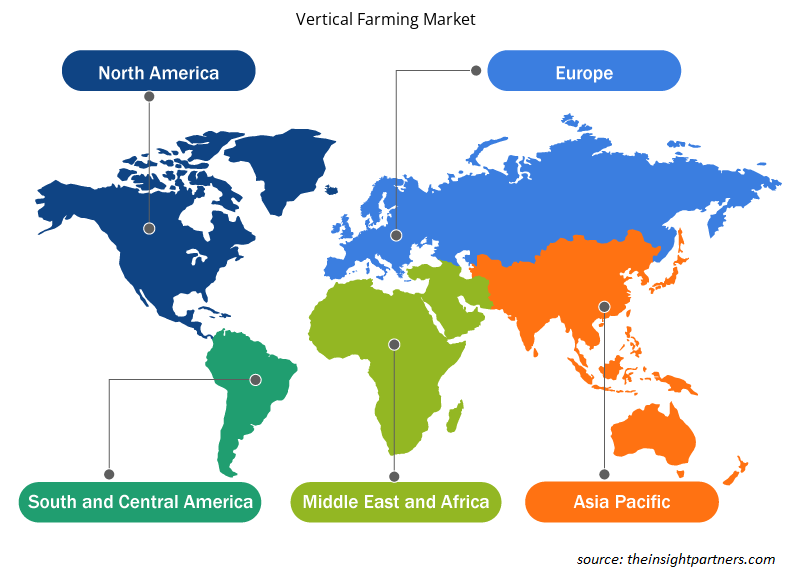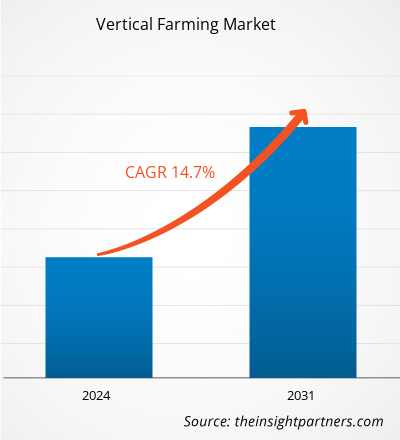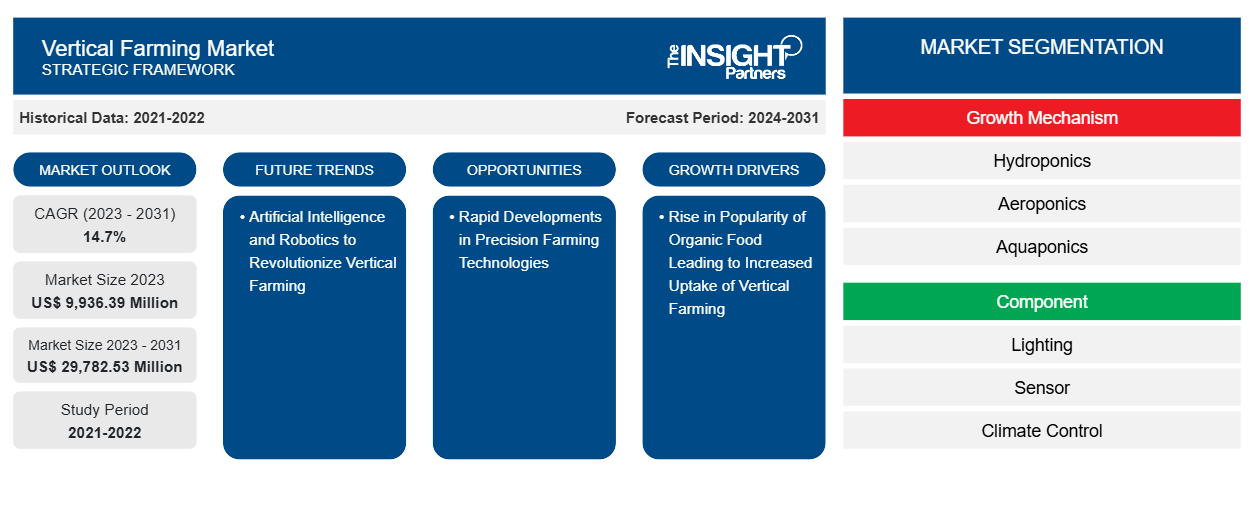Se proyecta que el tamaño del mercado de agricultura vertical alcance los 29.782,53 millones de dólares en 2031, frente a los 9.936,39 millones de dólares en 2023. Se espera que el mercado registre una CAGR del 14,7 % durante el período 2023-2031. Es probable que la creciente demanda de alimentos orgánicos y el creciente énfasis en la agricultura de precisión sigan siendo una tendencia clave en el mercado.
Análisis del mercado de agricultura vertical
El aumento de la población y la concienciación de los consumidores sobre los alimentos saludables son un importante impulsor de la agricultura vertical. La creciente preocupación por la agricultura inteligente y de precisión también está influyendo positivamente en el mercado de la agricultura vertical a nivel mundial. La falta de concienciación y el alto coste de mantenimiento son algunas de las razones que podrían obstaculizar el crecimiento del mercado. Sin embargo, se prevé que las crecientes iniciativas gubernamentales en favor de las técnicas de agricultura inteligente impulsen el crecimiento de la agricultura vertical durante el período de pronóstico.
Descripción general del mercado de agricultura vertical
La agricultura vertical es un proceso de cultivo o apilamiento de cultivos verticalmente. El proceso completo se lleva a cabo en entornos controlados utilizando métodos como la hidroponía, la aeroponía y la acuaponía . El proceso ayuda a cultivar cultivos en una cantidad de agua mucho menor que las técnicas agrícolas convencionales. Aparte de eso, la agricultura vertical también reduce la necesidad de pesticidas y otros pesticidas tóxicos para cultivar cultivos. La creciente urbanización y la creciente población están impulsando las necesidades de alimentos, lo que actúa como un impulsor del mercado. Las empresas farmacéuticas también se están centrando en la agricultura vertical en interiores para cultivar plantas biomédicas para medicamentos, que también es una de las principales tendencias positivas en el mercado a nivel mundial.
Personalice este informe según sus necesidades
Obtendrá personalización en cualquier informe, sin cargo, incluidas partes de este informe o análisis a nivel de país, paquete de datos de Excel, así como también grandes ofertas y descuentos para empresas emergentes y universidades.
-
Obtenga las principales tendencias clave del mercado de este informe.Esta muestra GRATUITA incluirá análisis de datos, desde tendencias del mercado hasta estimaciones y pronósticos.
Factores impulsores y oportunidades del mercado de la agricultura vertical
El aumento de la popularidad de los alimentos orgánicos favorece el mercado
La creciente conciencia de la salud y la inclinación hacia los productos alimenticios saludables están actuando como impulsores principales del mercado de la agricultura vertical. Los consumidores prefieren y muestran interés en consumir cultivos orgánicos como frutas, verduras y granos. La creciente conciencia de la salud es una de las principales razones detrás de la creciente demanda de los consumidores de productos alimenticios sin sustancias artificiales o químicos dañinos. Los crecientes riesgos para la salud relacionados con el consumo de cultivos o vegetales tratados químicamente están actuando como un impulsor importante de los alimentos orgánicos, lo que impulsa la demanda de la agricultura vertical. La creciente demanda de productos alimenticios no convencionales y orgánicos durante todo el año también está influyendo positivamente en el mercado a nivel mundial.
Inteligencia artificial y robótica para transformar la agricultura vertical
Se prevé que el creciente avance tecnológico en términos de automatización de procesos e integración de tecnología robótica brinde grandes oportunidades para el mercado de la agricultura vertical. Las granjas agrícolas que operan en el mercado están más enfocadas en actividades de investigación y desarrollo para introducir tecnología de inteligencia artificial para avanzar en el mantenimiento y cuidado de las plantas de una manera más organizada y optimizada. Además, algunas empresas también se están concentrando en introducir robots en la industria de la agricultura vertical para reducir la intervención humana y aumentar la eficiencia del tiempo, lo que también se proyecta que impulsará el crecimiento del mercado de la agricultura vertical a nivel mundial.
Informe de mercado de agricultura vertical Análisis de segmentación
Los segmentos clave que contribuyeron a la derivación del análisis del mercado de agricultura vertical son los mecanismos y componentes de crecimiento del producto.
- Según el mecanismo de crecimiento, el mercado se divide en hidroponía, aeroponía y acuaponía. El segmento de hidroponía tuvo una mayor participación de mercado en 2023.
- Por componentes, el mercado está segmentado en iluminación, sensores, control de clima, componentes de riego, material de construcción y otros. El segmento de iluminación tuvo una participación significativa del mercado en 2023.
Análisis de la cuota de mercado de la agricultura vertical por geografía
El alcance geográfico del informe del mercado de agricultura vertical se divide principalmente en cinco regiones: América del Norte, Asia Pacífico, Europa, Medio Oriente y África, y América del Sur y Central.
América del Norte lidera el mercado. La elevada inversión en tecnologías avanzadas para impulsar la producción de alimentos y aumentar la disponibilidad de frutas y verduras de temporada durante todo el año está impulsando la demanda de agricultura vertical en la región de América del Norte. La creciente demanda de frutas, cereales y verduras no convencionales y cultivadas de forma orgánica también está impulsando la evolución del mercado en América del Norte. Las variaciones de temperatura y las condiciones climáticas cambiantes son factores importantes que obstaculizan el crecimiento de verduras y frutas en varios países. Las naciones con condiciones de temperatura extremas están impulsando la demanda de agricultura vertical en América del Norte. La limitación de espacio también se ve satisfecha con la agricultura en capas apiladas, que es una de las principales razones detrás de la creciente adopción de técnicas de agricultura vertical. La creciente adopción de la automatización y el aumento de la tecnología robótica en el sector agrícola también están teniendo una influencia positiva en el mercado de la agricultura vertical en la región. Estados Unidos lidera el mercado de la agricultura vertical en América del Norte.
Perspectivas regionales del mercado de agricultura vertical
Los analistas de Insight Partners explicaron en detalle las tendencias y los factores regionales que influyen en el mercado de agricultura vertical durante el período de pronóstico. Esta sección también analiza los segmentos y la geografía del mercado de agricultura vertical en América del Norte, Europa, Asia Pacífico, Oriente Medio y África, y América del Sur y Central.

- Obtenga datos regionales específicos para el mercado de agricultura vertical
Alcance del informe sobre el mercado de agricultura vertical
| Atributo del informe | Detalles |
|---|---|
| Tamaño del mercado en 2023 | US$ 9.936,39 millones |
| Tamaño del mercado en 2031 | US$ 29.782,53 millones |
| CAGR global (2023 - 2031) | 14,7% |
| Datos históricos | 2021-2022 |
| Período de pronóstico | 2024-2031 |
| Segmentos cubiertos |
Por mecanismo de crecimiento
|
| Regiones y países cubiertos |
América del norte
|
| Líderes del mercado y perfiles de empresas clave |
|
Densidad de actores del mercado de agricultura vertical: comprensión de su impacto en la dinámica empresarial
El mercado de la agricultura vertical está creciendo rápidamente, impulsado por la creciente demanda de los usuarios finales debido a factores como la evolución de las preferencias de los consumidores, los avances tecnológicos y una mayor conciencia de los beneficios del producto. A medida que aumenta la demanda, las empresas amplían sus ofertas, innovan para satisfacer las necesidades de los consumidores y aprovechan las tendencias emergentes, lo que impulsa aún más el crecimiento del mercado.
La densidad de actores del mercado se refiere a la distribución de las empresas o firmas que operan dentro de un mercado o industria en particular. Indica cuántos competidores (actores del mercado) están presentes en un espacio de mercado determinado en relación con su tamaño o valor total de mercado.
Las principales empresas que operan en el mercado de agricultura vertical son:
- Tecnología verde del Edén
- Granjas Elevate Inc.
- iFarm
- OSRAM GmbH
- Plenty Unlimited Inc.
- Verdes del cielo
Descargo de responsabilidad : Las empresas enumeradas anteriormente no están clasificadas en ningún orden particular.

- Obtenga una descripción general de los principales actores clave del mercado de agricultura vertical
Noticias y desarrollos recientes del mercado de agricultura vertical
El mercado de la agricultura vertical se evalúa mediante la recopilación de datos cualitativos y cuantitativos a partir de una investigación primaria y secundaria, que incluye importantes publicaciones corporativas, datos de asociaciones y bases de datos. A continuación, se enumeran algunos de los avances en el mercado de la agricultura vertical:
- Eden Green Technology obtuvo 12 millones de dólares para su combinación de granja vertical e invernadero. (Fuente: Eden Green Technology, comunicado de prensa, marzo de 2024)
- Elevate Farms Inc. anunció la expansión de su presencia en el cultivo vertical de hortalizas de hoja verde tanto en Estados Unidos como en Europa. (Fuente: Elevate Farms Inc., comunicado de prensa, febrero de 2024)
Informe sobre el mercado de agricultura vertical: cobertura y resultados
El informe “Tamaño y pronóstico del mercado de agricultura vertical (2021-2031)” proporciona un análisis detallado del mercado que cubre las siguientes áreas:
- Tamaño del mercado de agricultura vertical y pronóstico a nivel mundial, regional y nacional para todos los segmentos clave del mercado cubiertos bajo el alcance
- Tendencias del mercado de la agricultura vertical, así como dinámicas del mercado, como impulsores, restricciones y oportunidades clave
- Análisis PEST y FODA detallados
- Análisis del mercado de agricultura vertical que cubre las tendencias clave del mercado, el marco global y regional, los principales actores, las regulaciones y los desarrollos recientes del mercado.
- Análisis del panorama de la industria y de la competencia que abarca la concentración del mercado, el análisis de mapas de calor, los actores destacados y los desarrollos recientes del mercado de la agricultura vertical
- Perfiles detallados de empresas
- Análisis histórico (2 años), año base, pronóstico (7 años) con CAGR
- Análisis PEST y FODA
- Tamaño del mercado, valor/volumen: global, regional y nacional
- Industria y panorama competitivo
- Conjunto de datos de Excel
Informes recientes
Testimonios
Razón para comprar
- Toma de decisiones informada
- Comprensión de la dinámica del mercado
- Análisis competitivo
- Información sobre clientes
- Pronósticos del mercado
- Mitigación de riesgos
- Planificación estratégica
- Justificación de la inversión
- Identificación de mercados emergentes
- Mejora de las estrategias de marketing
- Impulso de la eficiencia operativa
- Alineación con las tendencias regulatorias























 Obtenga una muestra gratuita para - Mercado de agricultura vertical
Obtenga una muestra gratuita para - Mercado de agricultura vertical